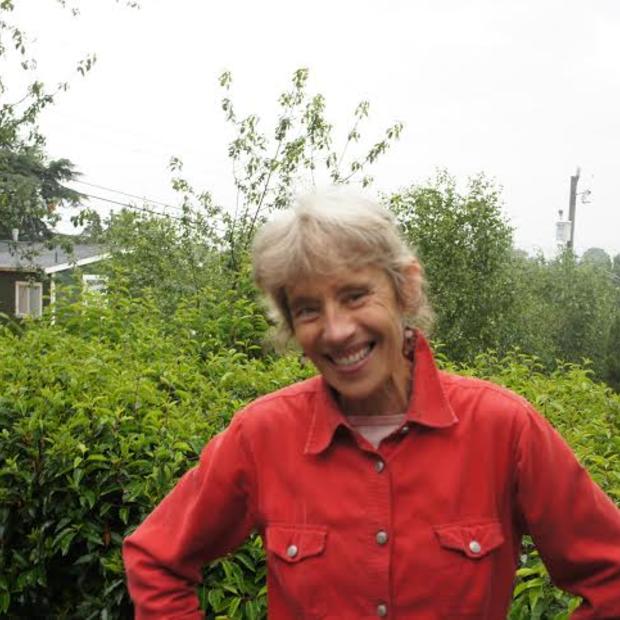Green Acre Radio continues to look at the “miasma” that runs into Puget Sound, as storyteller Stokley Tohles puts it. Other characters in this odd urban tale include a landscape designer, Seattle Public Utility and you, the public.
Click on the audio player above or here to listen.
There are three players to this urban tale, the storyteller, the landscape designer, and the public utility. Stokley Towles is the storyteller. Interestingly, a story about the contents of storm water and the predicament the region faces in keeping it out of Puget Sound, draws a crowd. Towles begins with what he calls a “traditional urban recipe”. You take motor oil, gasoline, cigarette butts and pet waste. Put them in a jar he advises. “You put them together and the miasma is well — just. ... [Audience laughter] Anyway you want to take these ingredients and you want to spread them over a hard surface, like the sidewalk that’s nearby or the street in front of your home.” Then wait for the rain to come and they wash into the city’s sewer system. What you end up with, says Towles, is “nice fresh stormwater.”
Okay. So now the crowd knows what storm water is, but what’s the solution? That’s where Stephen Appleyard comes in. He’s with Seattle Rain Garden, a landscape construction company that specializes in green stormwater infrastructure and rain gardens. “So the deal is this. You can’t shoot your municipal sewage into the nearest body of water. That’s uncool.” In 2010, 190 million gallons of untreated raw sewage and storm water discharged into Puget Sound waterways. During the wet season the overflow is the main contributor to the decline in water quality in Puget Sound. “With development and paving and loss of tree canopy over time what’s happening is the system can’t handle the capacity we place on it.” This is where the third player in the urban tale comes in, Seattle Public Utilities. How can they manage these massive volumes of run off with a hundred year old sewer system, a system designed to carry both sewage from inside homes and rainwater from rooftops and streets in a single pipe, or “combined sewer.”
Last summer Seattle Public Utilities launched an experiment called RainWise, a project to encourage homeowners to install rain gardens. Ballard was chosen as the test site because that’s where the sewage overflow problem is the worst. Forty-three million gallons overflowed into the Ship Canal and Salmon Bay waterway, 25 percent of the citywide total. Rainwise offers rebates to private property owners willing to build rain gardens or cisterns to collect run off. Appleyard looks at a small house with two new trenches in the front. Water running off this roof dumps nearly 70,000 gallons of storm water into the sewer system a year. "Instead of taking that stormwater and putting it into the combined sewer system, we’re going to put it into these beautiful little — well, someday they’ll be beautiful, little gardens.” Homeowner Emily Goldsmith says she’s going to plant smoke bush, reed grass, and a weeping Cedar. “It’s nice that we can actually see the pipes dripping down into the up-and-coming rain gardens.” Everything was paid for from soil sampling and measuring the roof line, to digging underground trenches for rain spouts and exposing them in above ground rain trenches.
The Clean Water Act requires that overflows from combined sewers occur no more than once a year. Yet in 2010, Seattle sewers overflowed 339 times. In 2009 the EPA issued a compliance order directing the city and county to step up efforts to reduce sewer overflows. King County controls storm basins of 1,000 acres or more and the city all the smaller basins. “If we’re not able to achieve our targets just using green infrastructure, which our current estimates are that we can’t, we also need to partner that with gray infrastructure.” Tracy Tackett is with Seattle Public Utilities. Gray infrastructure means underground tanks to hold sewage and storm water. But the utility won’t select where to build the tanks until 2015. Until then efforts to contain run off will largely come through the Rainwise program. In 2012 the program will expand to Montlake and the north part of North Union Bay (the Windermere neighborhood), where runoff into waterways is equally problematic.
But convincing the public — really the fourth player in this urban tale — of the severity of the problem is perhaps one of the biggest challenges of all. Back at the event with Stokley Towles, many admit they came because of Towles skills as a performance artist. One person when asked if he’d consider putting in a rain garden replied. “No. We live on top of a hill. There’s no collected water up where we are.”
But if the water you collect concerns you, which means everything from the water that flows off your roof to the water you use when you flush the toilet, you might want to check out Seattle Public Utilities' RainWise program. The non-profit, Sustainable Seattle, will hold rain garden workshops on Nov. 14 and 16.
Green Acre Radio is brought to you this week with support from the Russell Family Foundation. Engineering by CJ Lazenby. Produced through the Jack Straw Foundation and KBCS.



